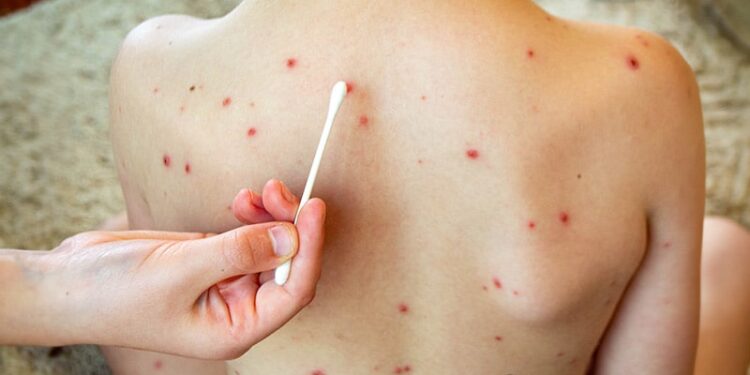For 30 years, pediatrician Tammy Camp, MD, of Lubbock, Texas, never once encountered a case of measles on the job. Now, that’s all changed. As she told colleagues last week, that’s not all that’s different in West Texas, the epicenter of the 2025 measles outbreak in the Southwest.
“We’re seeing mothers who are scared, crying in the clinic because they have a baby that they have delivered just 6 weeks ago and they know that the child is too young to receive a measles vaccine,” she said in a National Academy of Medicine update about the outbreak. “Yet, they know they need to return to work because they are responsible for putting food on the table for the rest of their family members.”
To make matters more complicated, Camp has to worry about disease transmission in her clinic. While Lubbock is 90 miles from the outbreak’s rural ground zero in the tiny Gaines County, the city is treating many infected people, including most of the pediatric patients who’ve been hospitalized.
There’s more. “The other thing that’s been difficult has been watching our residents and faculty struggle with the pain of watching a child suffer from a disease that they know is completely preventable, something that does not have to happen,” she said.
Fortunately, the measles outbreak in the Southwest seems to be slowing. “We do believe a lot of that has to do with the community awareness of what’s going on. We have increased immunity, both actively through infection and passively through vaccines,” said Tiffany Torres, MPH, MS, surveillance, epidemiology and laboratory manager at the Lubbock Public Health Department.
Still, she said, “we don’t believe this outbreak is done yet.”
Outbreak Spread Amid Lower Vaccination Rates
As of late May, the Centers for Disease Control & Prevention has confirmed 1046 measles cases in 30 states and three deaths. Since 2000, only 2019 has seen more reported cases in the United States.
Yvonne “Bonnie” Maldonado, MD, professor of pediatrics and infectious diseases at Stanford University, Palo Alto, California, said measles remains one of the most infectious viruses known, with an estimated basic reproduction number (R0) of 12-15.
“This means about 12-15 susceptible individuals who are exposed to an infected individual will become infected,” she said. “This is one of the highest, if not the highest, R0s that we know of. We need levels of about 95% population immunity in order to prevent sustained transmission,” she said.
However, the percentage of US kindergarten students who’ve received measles, mumps, and rubella (MMR) vaccinations dropped to 92.7% in the 2023-2024 school year, Maldonado said.
Public Health Workers on the Frontlines
In the Southwest, Lubbock Public Health Department’s Torres said her team swung into action after the first measles case by setting up a mass online meeting for medical professionals across West Texas and the Panhandle.
“We wanted to spread all the guidance that we had available and offer recommendations for postexposure prophylaxis of close contacts, as well as the vaccine options for those who are eligible to receive an MMR vaccine,” she said.
The health department helped with reporting, contact tracing, and testing, Torres said. “We also increased our vaccine efforts, removing any barriers that may have been for people to receive an MMR. We identified gaps in vaccine coverage. We found those areas that may have a low vaccine rate and sent a strike team out to the areas to try to boost that vaccine coverage prevent the spread to other communities as well.”
Health workers have focused special attention on daycare facilities, she said. “We want to be sure to avoid getting any kind of infection [in infants] because it’s very, very difficult to stop the transmission. Most of them cannot receive an MMR vaccine.”
Building Trust and Getting Injections in Arms
How can medical professionals fight back against the influence of the antivaccine movement? Heidi Larson, PhD, founder of the Vaccine Confidence Project, said her research has shown that that language matters: Messaging that focuses on “protection” and shared responsibility tends to resonate better than language invoking “moral obligation.”
“People’s willingness [to be vaccinated] is always higher when they see it’s benefiting others,” said Larson, a professor at the London School of Hygiene & Tropical Medicine and University of Washington, Seattle.
During the COVID-19 pandemic, Larson’s team worked with platforms like YouTube to promote campaigns built around returning to valued activities — ”getting back to what you love” — rather than focusing on data alone.
She also noted that in the United States, people are more likely to trust family and community leaders than physicians. “Medical professionals are trusted, but they are part of a larger trust ecosystem. Peer influence is a powerful tool.”
As she put it, “people trust their family more than scientists. They trust friends more than scientists.” In addition, religious leaders in the US score higher than in other countries. “These are the influencers,” she said, “even though we still have high trust in scientists and healthcare professionals.”
What does that mean for measles prevention? “We need facts and figures, of course. But we also need to appeal to people’s emotions, to stories.”
Disclosure information for speakers was not available.
Source link : https://www.medscape.com/viewarticle/measles-update-inside-battle-stop-outbreak-2025a1000esh?src=rss
Author :
Publish date : 2025-06-02 11:09:00
Copyright for syndicated content belongs to the linked Source.














